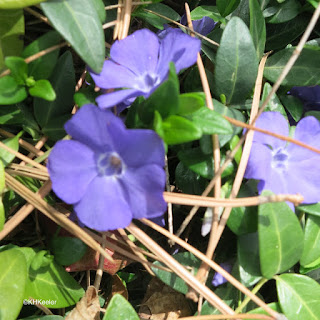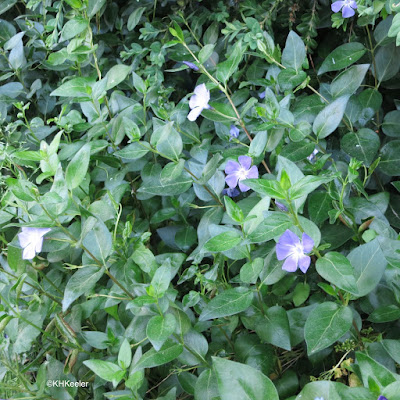The name periwinkle is an old English name for a group of plants native to Europe and the Middle East in the genus Vinca. The name periwinkle has been applied to a number of other plants, particularly related plants from the tropics with similarly-shaped flowers (Catharanthus). Periwinkle is also the name of a common seashell (Littorina littorea) and its relatives photos. I'll talk about the two species of perennial, creeping blue-flowered plants, Vinca major and Vinca minor, commonly planted all across the United States and much of Canada. You can find ornamental forms of periwinkle with variegated leaves and with flowers shading from deep blue-purple to white. Vinca minor, the common periwinkle is a little smaller but more winter-hardy than the greater periwinkle, V. major. They are members of the dogbane family Apocynaceae.
The periwinkles in the genus Vinca open their first flowers quite early, when crocuses are in full bloom and as daffodils start to flower. Periwinkle flowers are a lovely shade of blue-purple which is well enough known to appear in poetry and clothing catalogs as a color name (periwinkle color). They are widely planted as a ground cover. Seeds seem to be rare, at least in North America.
Although native to central and southern Europe and western Asia the two commonly-planted periwinkles, the common periwinkle and the greater periwinkle, were introduced to northern Europe and the British Isles very long ago.
The name periwinkle began as vincapervinca, the name in Latin that Pliny the Elder used in the first century AD. Pervinca is from vincire, to bind or entwine (ancestor of our words vine and bind). In Middle English it had become pervenke and in Modern English periwinkle. The sea shell, by the way, started out called pina, its colloquial Latin name, to which Old English added wincel, a sea shell. Pinawincel morphed into periwinkle, converging with the plant name.
Periwinkles (the plants) have a rich history in Europe, having been used medicinally since at least Roman times. Dioscorides (64 AD) wrote that the leaves and stalks drunk in wine stop dysentery and chewed, the leaves cure the pains of the teeth. Gerard in his Herball (1633) endorsed periwinkle leaves crushed in red wine to stop bloody flux (dysentery) and spitting of blood because it "never faileth in any bodie, either man or woman." He said it likewise stopped excessive menstual bleeding. My modern source (PDR for Herbal Medicine) considered all periwinkle's medicinal uses unproven, noted that overdosing will bring a sudden drop in blood pressure but that no one has reported periwinkle poisoning.
The folklore and folk uses go well beyond physicians like Dioscorides. Medical uses reported to ethnobotanists in the British Isles included treating chapped hands, minor cuts and nosebleeds and giving it to people for nervous disorders, hysteria and nightmares. The leaves reportedly have some sedative effects.
Pliny the Elder, in his Natural History, described periwinkles as used for "chaplets when there is a deficiency of other flowers," the creeping nature of the plant allowing them to be easily woven into circlets. Periwinkles are evergreen in most of Europe so are available all year for chaplets. Chaplets, circlets of leaves or flowers for the head, were very common in Europe from Roman times through the Middle Ages but have largely been forgotten.
The lore of periwinkles expanded so that they became a symbol of both immortality and love between husband and wife. The former perhaps follows because it is evergreen, the latter because it easily twines.
In medieval Europe periwinkles were frequently made into garlands for the burial of children and planted on graves. Furthermore periwinkle branches adorned the condemned. An English rhyme went
"Crowned one with laurel leaves hye on his head set
other with pervink made for the giblet."
The Book of Secrets of Albertus Magnus, published in England in the 1500s as the printing press allowed the dissemination of previously rare books, is a collection of fairly fantastic plant lore. It was probably not written by Albertus Magnus, a respectable scholar of the 12th century nor is it likely that most Elizabethans found it credible. But it certainly reports medieval folklore. About periwinkle it says "When it is beaten unto powder with worms of the earth wrapped about it, and with an herb called Semperviva, the English Houseleek, it induceth love between man and wife, if it be used in their meats." (p. 8). Yuck! I found The Book of Secrets in the University of California Berkeley's library years ago. Today you can see it (online) without a trip to California (see references).
Less dramatic uses of periwinkles for love included tying them into "love knots." In the wedding poem, "Something old,
Something new,
Something borrowed,
Something blue"
the something blue was widely interpreted as referring to periwinkles, which, ideally, were wrapped around the bride's thigh as a garter, for a fertile marriage. Beyond that, newlyweds planted periwinkles in the garden to ensure a long and happy marriage.
That's just a bit of the folklore of periwinkles. The blue color made periwinkles flowers of heaven and symbols of Jesus, Mary and the angels in Heaven, so in medieval Europe one might carry or wear periwinkles as a reminder of Heaven and its grace. At the other extreme, they were the "sorcerer's violet," but none of my books says more than that. Of course you'd put them into love potions. In addition, carrying periwinkles was supposed to produce prosperity and keep away dangerous beasts, poisonous snakes, terror, and evil spirits. Gazed upon, they restored lost memories.
Ah, there's a task for you: stop at the next periwinkle, regard it carefully...and note what you suddenly remember.
Comments and corrections welcome.
References
Allen, D. E. and G. Hatfield. 2004. Medicinal plants in folk tradition. An ethnobotany of Britain and Ireland. Timber Press, Portland, Oregon.
Best, M. R. and F. H. Brightman, editors. 1973. The book of secrets of Albertus Magnus. Originally published 1550. Online at Google Books p. 8, periwinkle link Read on to get a feel for the book.
Bostock, J. and H. J. Riley editors and translators. 1885. Pliny the Elder. Natural History. Book XXL. Chapter 39 link
Cunningham, S. 1985. Cunnigham's encyclopedia of magical herbs. Llewellyn Publishers, St. Paul, Minnesota.
Durant, M. 1976,. Who named the daisy? Who named the rose? Cogdon and Weed, Inc. New York.
Fisher, C. 2013. The medieval flower book. The British Library, London.
Gerard, J. 1975. The herbal or general history of plants. 1633 edition. Dover Publications, New York.
Goody, J. 1993. The culture of flowers. Columbia University Press, New York. (discussion of chaplets)
Gunther, R. 1933. The Greek herbal of Dioscorides. Originally 64 AD. Oxford University Press, Oxford.
Missouri Plant Finder. No date. Vinca minor Plant description and planting details: link
PDR (Physician's Desk Reference) for Herbal Medicine. 2007. 4th edition. Thompson Publishing, Montvale, New Jersey.
Pollington, S. 2000. Leechcraft, early English charms, plantlore and healing. Anglo-Saxon Books, Norfolk, England.
Rich, V. A. 1998. Cursing the basil and other folklore of the garden. Horsdal and Schubart, Victoria, British Columbia.
Vickery, R. 1995. Oxford dictionary of plant-lore. Oxford University Press, Oxford.
Kathy Keeler, A Wandering Botanist
More at awanderingbotanist.com





The plant story of the Merry Periwinkle, Vinca is very interesting. I never know that much about this plant. Keep posting these kind of blogs. Thanks
ReplyDeleteThese flowers are damn beautiful with different colors. I like to have them in my garden because they always give you a fresh look of your garden and are easy to grow even.
ReplyDeleteI affirmed examining your articles. picbear
ReplyDeleteI just love the Periwinkles!
ReplyDeletePeriwinkle lovers can also check this Mindblowing post Periwinkle growing techniques that really helped me with my vinca.